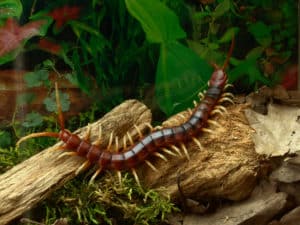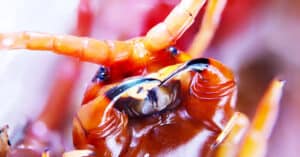- As a result, they can help to keep the population of indoor pests in check.
- They are also capable of reproducing without entering into physical contact with each other.
Centipedes are predators. Insects with flat, elongated, segmented bodies. All segments except the last have their own pair of legs. Centipedes come in a number of patterns and colors. The most common though is reddish-orange and brown.
Centipede means “100 legs.” And while there are centipedes with what seems like thousands of legs, no one has exactly one hundred. That’s due to the fact centipedes always have an odd number of pairs.
A centipede’s number of legs can change. It often sacrifices a few limbs when in the grip of a predator. The insect makes a fast exit while leaving its enemy holding lifeless legs. The damage is repaired when new legs regenerate during the molting stages. Should you ever notice a centipede with legs shorter than others, that’s probably because it’s recovering from an attack.
There are close to 3,000 species of centipedes on record. They are frequently grouped with millipedes and minor subspecies in the superclass Myriapoda. Despite the categorization, centipedes and millipedes are easily distinguished as millipedes have two pairs of legs with each segment.
The house centipede has long legs and runs rapidly. The largest of the breed can grow as long as six inches. In general, the worst effects of a centipede bite are mild swelling and pain, if there’s any impact at all. The Scolopendra may be the most dangerous species of all centipedes due to its powerful venom.
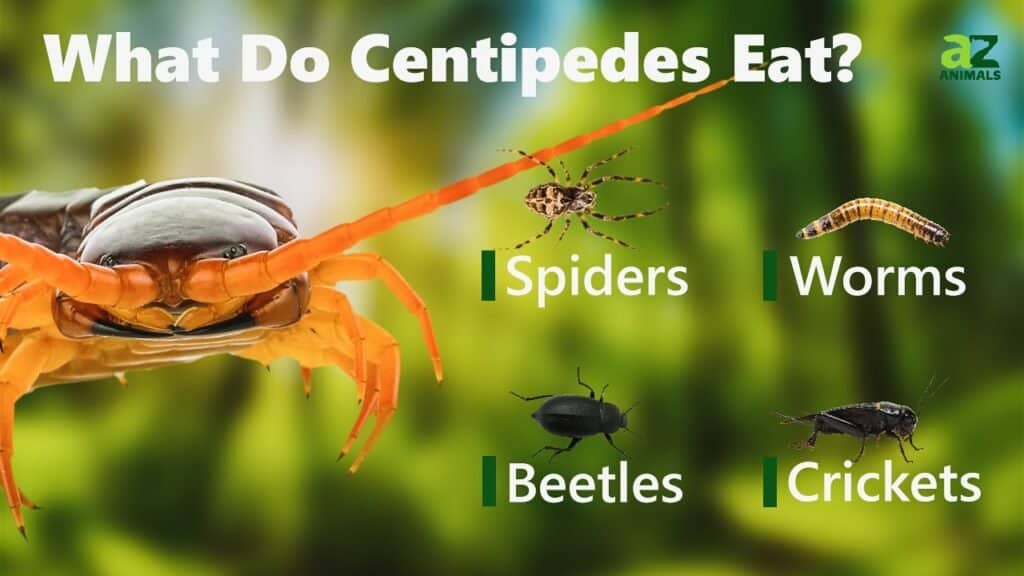
Are Centipedes Dangerous for Humans?
Centipedes are predatory but not dangerous to humans. Their venom isn’t powerful enough to affect humans or larger animals. Still, they are not welcome everywhere. Many find their rapid movement alongside an unsettling appearance disturbing.
You can find these creatures indoors any time of year but looking to escape cold winters they sink cold winters. The animals go looking for an indoor sanctuary. The ideal place is moist and dark. A secluded space that provides food.
The creatures get in through crevices and cracks. They climb up and enter using drains. The insects immediately seclude themselves in basements, closets, bathrooms, and beneath your sinks.
Being nocturnal, centipedes are rarely seen by homeowners. When discovered, it’s usually as they scamper up a wall or along the floor.
Despite their creeping and creepy appearance, many in the insect community argue the benefits of house centipedes. They help minimize the pest populace by hunting and killing silverfish, flies, moths, roaches and termites. The centipede doesn’t create nests or webs. They’re not associated with fatal diseases or eat away at wood or other materials and gradually damages the infrastructure of your property or furnishings.

©iStock.com/Víctor Suárez Naranjo
Reproduction
Solitary in nature, most species of centipede can mate without any direct contact. Males spin webs and deposit their sperm in them. Upon locating the webs, females take them and fertilize their ova. There are species of centipede that do have courtship rituals.
Outdoor centipedes set up reproduction shop in soil. Egg-laying happens throughout the spring and summer, especially in temperate areas. In tropical and subtropical areas, many eggs are laid at any given time. Indoors, the centipede looks for the usual moist, dark spaces.
When the eggs hatch, you get miniature adult centipedes. Most only have a fraction of their leg sets. The majority of their limbs will come in after a series of molts.
Getting Their Diet On
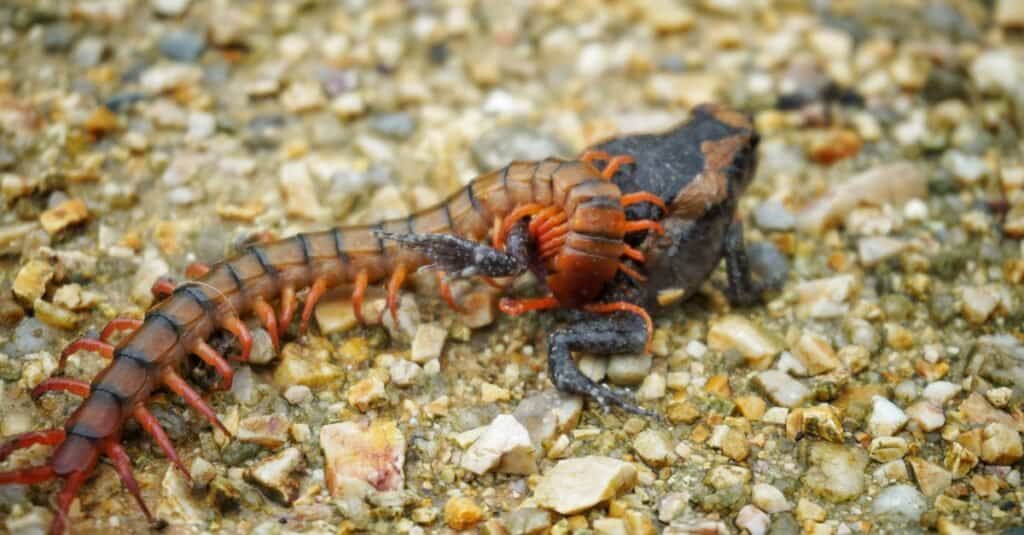
©WITSANU PORNSUKNIMITKUL/Shutterstock.com
Centipedes have very poor vision. They’re able to locate prey with their antennae. When prey closes in, the insect uses speed to race over and capture. They immediately attack, injecting the prey with paralyzing venom. The act’s conducted via claws on the creature’s first body segment.
With its prey subdued, the centipede passes its capture to its mandibles, chewing and consuming prey.
The centipede is a nocturnal and carnivorous predator. For its diet, the creature goes after small animals and insects. Here is a shortlist of the insect’s potential prey.
- Cockroaches
- Moths
- Spiders
- Earthworms
- Silverfish
- Crickets
- Bedbugs
Carnivorous centipedes also tend to be cannibalistic, not hesitate to eat their own kind, especially if they are injured in some way. The characteristic stems from the creature’s being naturally solitary and extremely antisocial. Though you can find centipedes living in groups, the animals tend to become violent around other centipedes.
How is a Centipede’s Diet Helpful?
Centipedes are omnivorous and active hunters. There isn’t much else they do except spend every moment of their life looking for food. They tend to munch on critters we pretty much don’t want around. That’s various insects and spiders, and other small invertebrates. Larger centipedes will attack and eat vertebrates like lizards.
Predators
Centipedes are easy prey to badgers, wasps, shrews, toads, birds and chickens. Other animals on the prey list include ants, spiders and ground beetles. The centipede also has a taste for smaller snakes.
When not hunting, centipedes are in hiding, avoiding their predators. Underneath rocks are one of their favorite places. They also like piles of dead leaves and digging into the soil. They use speed to their advantage as well, as many creatures cannot keep up with them. And, of course, they’ll use their venom to paralyze a predator given the opportunity.
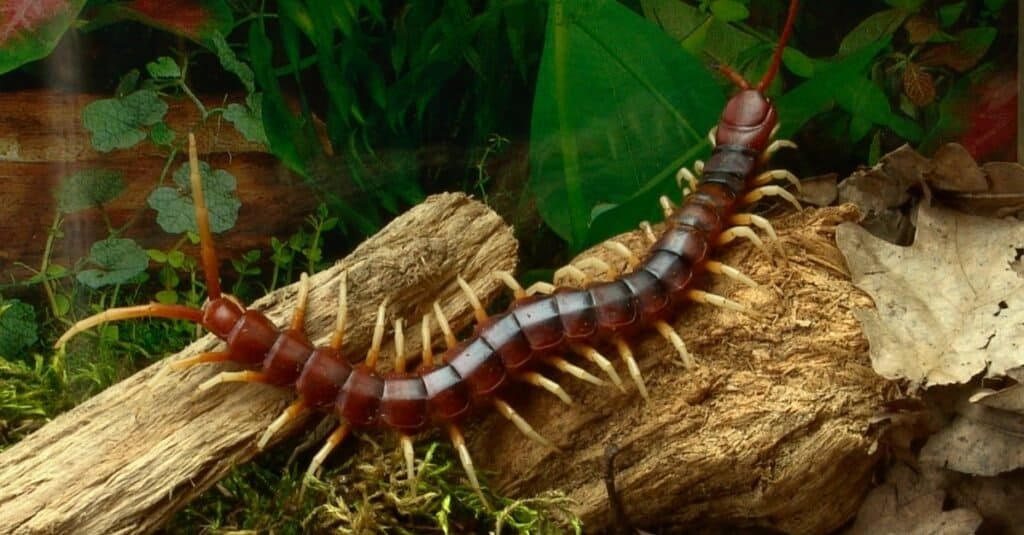
©skifbook/Shutterstock.com
Getting Rid of Centipedes
Despite hearing all the benefits of having centipedes around, we haven’t found anyone who’s ready to make the centipede members of the family. Here are natural ways to combat a centipede population.
- The only real way to get rid of carnivorous centipedes is to eliminate the food sources they eat. Without household pests to feed on, centipedes will look elsewhere.
- You might have excess moisture in the walls. Use a dehumidifier to remove moisture or put a fan in the bathroom.
- Go through the house and seal cracks and gaps. Not only do centipedes (and other unwanted insects) use them to get in, they also use those spaces to keep their lineage going.
- Clear your environments of debris that creates unnecessary moisture that may leak into the walls.
- Outdoors, remove compost, wood, junk and leaf piles.
- Remove any bodies of water, apply door sweeps and trim around plants.
- Use well-insulated windows and doors.
- Hire a professional exterminator.
Up Next…
Keep reading these posts for more incredible information about key animal facts.
- 10 Incredible Centipede Facts: The largest of them can grow up to half a foot. And they’re not averse to taking on small animals at that point. Discover more astounding facts on centipedes right here.
- Types of Centipedes: 8 of the Most Fascinating Centipede Species: Some of them are capable of growing up to almost a foot in length and delivering very painful bites to boot, others come in bright colors and are kept as pets. And you can read all about them and many others, in this post.
- Millipede vs. Centipede: The 7 Key Differences Explained: Who’s venomous and who isn’t? Who lives longer? Who’s capable of taking on mice and reptiles? Click on the link to find out.
The photo featured at the top of this post is © iStock.com/Nattawat-Nat
Thank you for reading! Have some feedback for us? Contact the AZ Animals editorial team.



